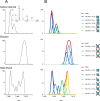Characterizing Endogenous Protein Complexes with Biological Mass Spectrometry
- PMID: 34406752
- PMCID: PMC9052418
- DOI: 10.1021/acs.chemrev.1c00217
Characterizing Endogenous Protein Complexes with Biological Mass Spectrometry
Abstract
Biological mass spectrometry (MS) encompasses a range of methods for characterizing proteins and other biomolecules. MS is uniquely powerful for the structural analysis of endogenous protein complexes, which are often heterogeneous, poorly abundant, and refractive to characterization by other methods. Here, we focus on how biological MS can contribute to the study of endogenous protein complexes, which we define as complexes expressed in the physiological host and purified intact, as opposed to reconstituted complexes assembled from heterologously expressed components. Biological MS can yield information on complex stoichiometry, heterogeneity, topology, stability, activity, modes of regulation, and even structural dynamics. We begin with a review of methods for isolating endogenous complexes. We then describe the various biological MS approaches, focusing on the type of information that each method yields. We end with future directions and challenges for these MS-based methods.
Conflict of interest statement
The authors declare no competing financial interest.
Figures








References
Publication types
MeSH terms
Substances
LinkOut - more resources
Full Text Sources

